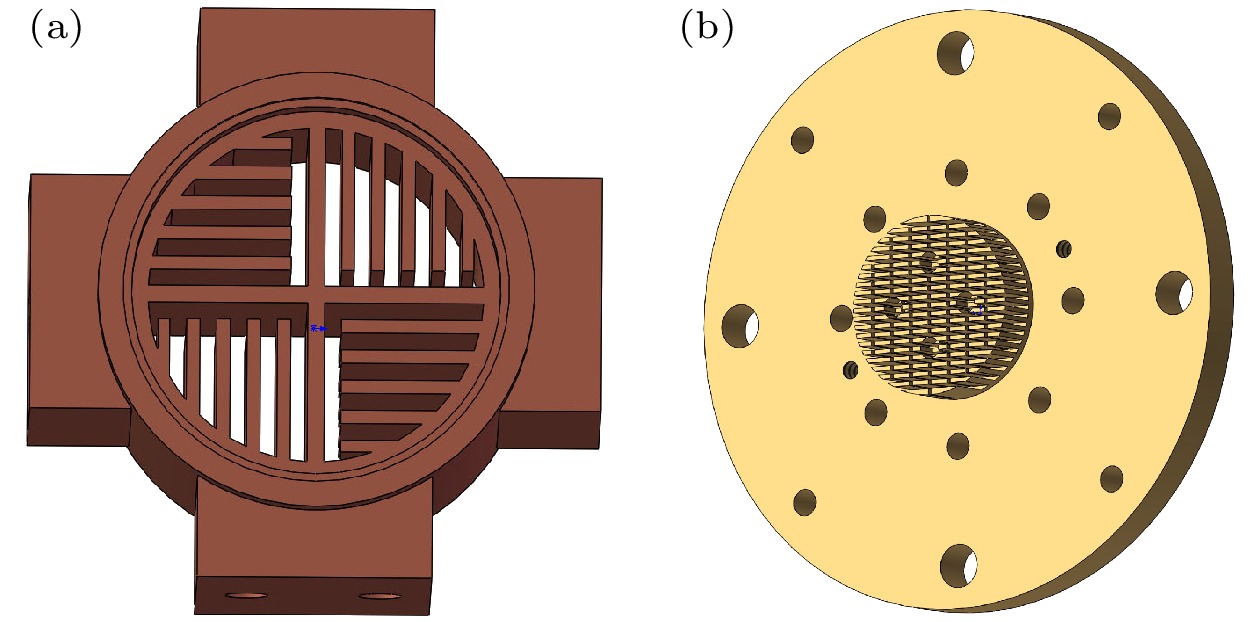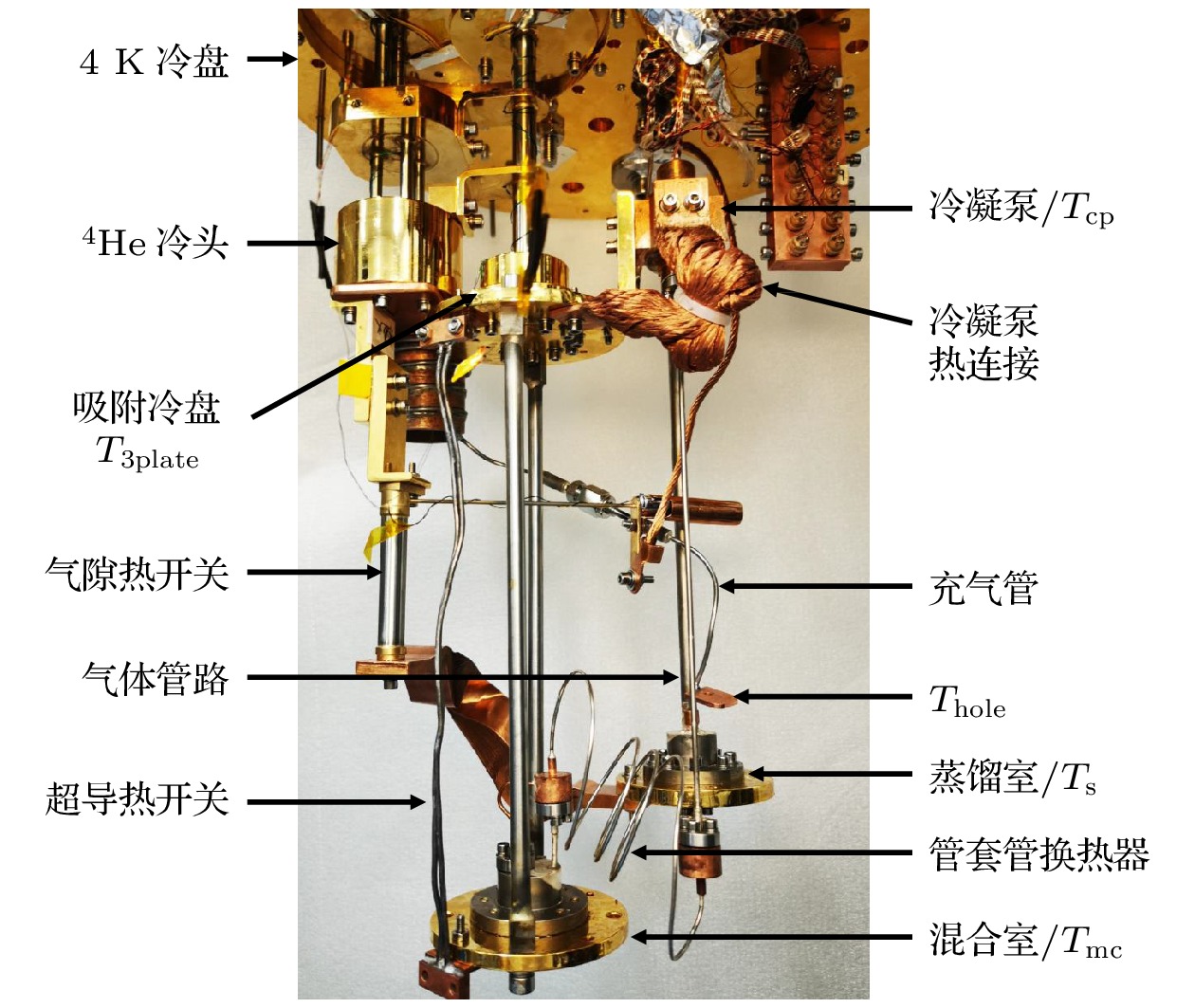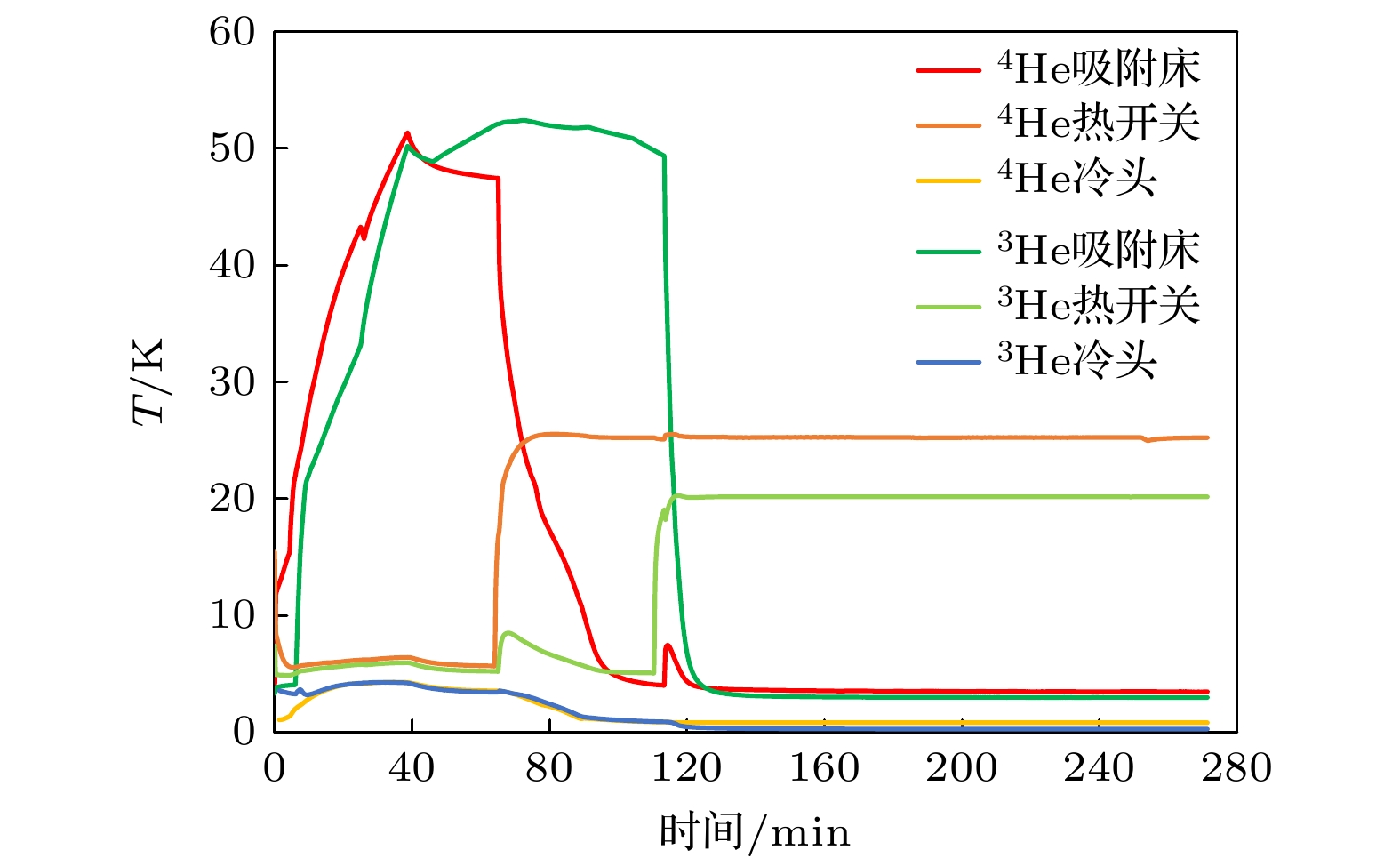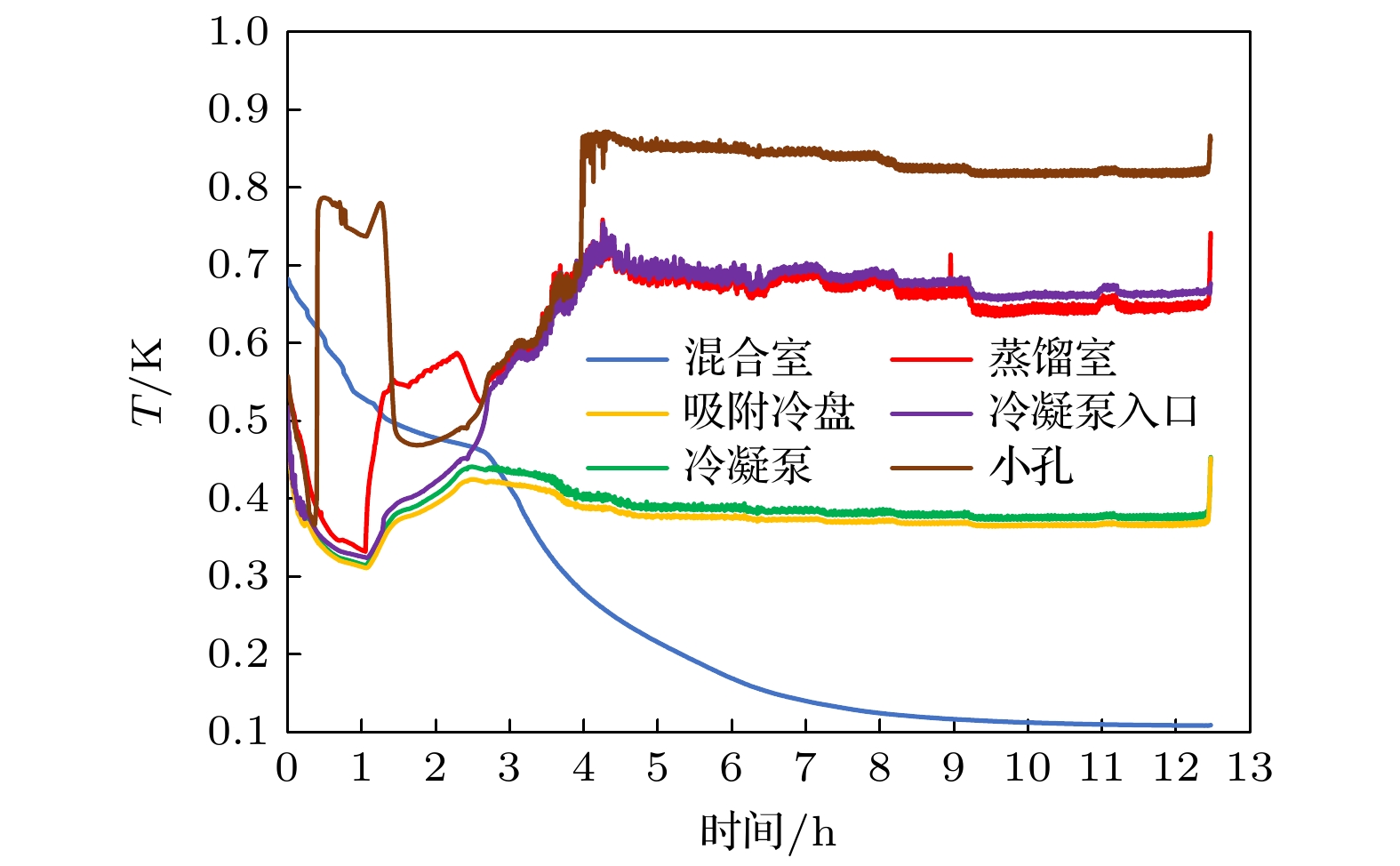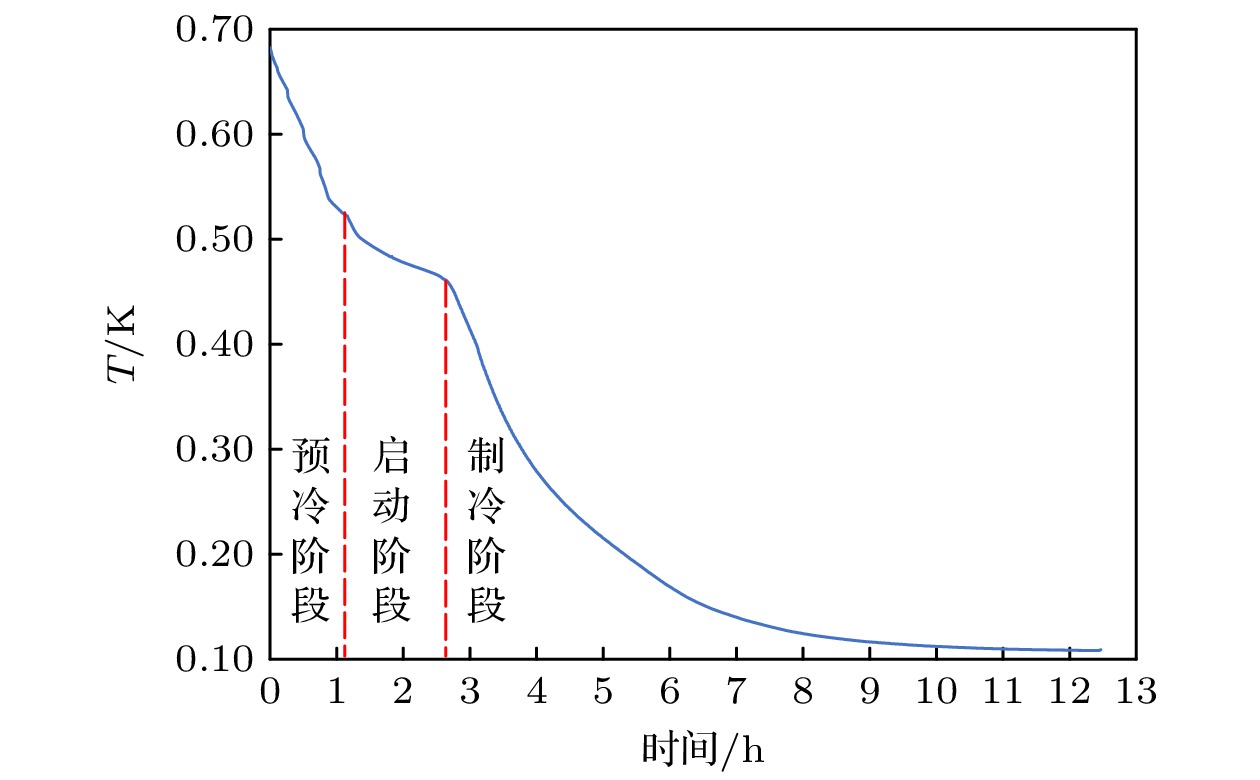-
极低温(< 1 K)环境对于凝聚态物理、天文观测和量子计算等前沿领域具有重要意义, 其中稀释制冷是应用最广泛的极低温制冷技术. 针对小冷量应用的冷凝泵型稀释制冷机利用冷凝泵实现3He的低温循环, 无需复杂的机械泵组和连接气路, 具有结构紧凑、操作便利、成本低等优势, 从而成为新的研究热点. 本文围绕冷凝泵型稀释制冷机, 介绍了其制冷原理和系统架构, 设计并搭建了预冷系统、稀释低温系统和测量系统, 并对整机进行了实验研究. 辅助多测温点测量系统, 通过多次实验总结了稀释低温循环过程, 由吸附制冷机预冷、稀释循环启动和稀释制冷三个阶段组成, 并且分析了系统启动和运行特性. 经过测试, 实验最低温度可达108 mK. 该制冷机可以很方便地拓展低温平台的制冷温区, 为凝聚态物理、材料、医学研究等前沿领域提供重要支撑.
Subkelvin refrigeration is necessary for many frontier research fields such as condensed-matter physics, astronomical observation, and quantum computing. Dilution refrigeration utilizes the entropy increase of 3He atoms when they flow from the concentrated phase to dilute phase to provide cooling, and has the advantages of continuous operation, large cooling power and no electromagnetic interference. It is the most widely used method among subkelvin refrigeration at present. For research scenarios requiring small cooling powers, the condensation-pump dilution refrigerator utilizes a condensation pump to achieve cold cycle of 3He, with no need of complex ambient pump systems or gas circuits, and has become a new research topic because of its compact structure, convenient operation and low cost. A condensation-pump dilution refrigerator is built and investigated in this work. The refrigerator consists of a mixing chamber, a continuous tube-in-tube heat exchanger, a still, and a condensation pump, and it is precooled by a GM-type pulse tube cryocooler below 4 K and an adsorption refrigerator below 400 mK. The 3He evaporates from the still, condenses in the condensation pump and provides cooling in the mixing chamber after being precooled in the heat exchanger. By means of the multi-temperature measuring system, the cold cycle of the dilution refrigerator can be summarized as three stages: precooling by the adsorption refrigerator, cycle start-up, and continuous dilution cooling. The operating characteristics of the system are analyzed. The experiments showed that the lowest no-load temperature reached 108 mK when the condenser temperature was 378 mK. Meanwhile, the temperature oscillation appeared, and the possible reasons are analyzed. In the future, the system performance will be improved by 1) adjusting the spiral mode and position of the continuous tube-in-tube heat exchanger and 2) increasing the heat transfer area between the cold plate and the fluid in the mixing chamber to reduce the fluid-solid temperature difference. The refrigerator introduced in this work can easily expand many existing cryogenic platforms working at higher temperatures, and effectively support developments of high-end equipment. [1] Pobell F 2007 Matter and Methods at Low Temperatures (3rd Ed.) (Berlin Heidelberg: Springer) p467
[2] London H 1951 Proceedings of International Conference on Low Temperature Physics (LT2) Oxford, UK p157
[3] Das T P, Ouboter R D B, Taconis K W 1965 Proceedings of Ninth International Conference on Low-Temperature Physics Ohio, US, August 31–September 4, 1964 p1253
[4] Cousins D J, Fisher S N, Guénault A M, et al. 1999 J. Low Temp. Phys. 114 547
 Google Scholar
Google Scholar
[5] Zu H, Dai W, de Waele A T A M 2022 Cryogenics 121 103390
 Google Scholar
Google Scholar
[6] Ji Z, Fan J, Dong J, Bian Y, Cheng Z G 2022 Chin. Phys. B 31 102703
 Google Scholar
Google Scholar
[7] Brisson J G 1998 J. Low Temp. Phys. 111 181
 Google Scholar
Google Scholar
[8] May A J 2016 M. S. Thesis (Manchester: The University of Manchester)
[9] Mikheev V A, Maidanov V A, Mikhin N P 1984 Cryogenics 24 190
 Google Scholar
Google Scholar
[10] Mohandas P, Cowan B P, Saunders J, et al. 1994 Physica B 194 55
 Google Scholar
Google Scholar
[11] Prouvé T, Luchier N, Duband L 2008 Cryocoolers 15 California, US, June 9–12, 2008 p497
[12] Teleberg G, Chase S T, Piccirillo L 2006 Proceedings of SPIE p6275OD-1
[13] May A J 2019 Ph. D. Dissertation (Manchester: The University of Manchester)
[14] May A J, Azzoni S, Banys D, Coppi G, Haynes V, McCulloch M A, Melhuish S J, Piccirillo L, Wenninger J ICEC-ICMC 2018, IOP Conference Series: Materials Science and Engineering Oxford, United Kingdom, September 3–7, 2018 p0121351
[15] Azzoni S, May A, Chase S, Coppi G, Kenny L, Melhuish S, Piccirillo L, Suzuki A, Wenninger J 2020 J. Low Temp. Phys. 199 771
 Google Scholar
Google Scholar
[16] Chase S T, Brien T L R, Doyle S M, Kenny L C 2018 IOP Conference Series: Materials Science and Engineering Oxford, United Kingdom, September 3–7, 2018
[17] Sivokon V E, Dotsenko V V, Pogorelov L A, Sobolev V I 1992 Cryogenics 32 207
 Google Scholar
Google Scholar
[18] Wheatley J C, Rapp R E, Johnson R T 1971 J. Low Temp. Phys. 4 1
 Google Scholar
Google Scholar
[19] Zu H Y, Li K, Wang X T, Wang Y N, Shen J, Dai W 2022 Cryocoolers 22 Boulder, USA, June 27–30, 2022 p365
[20] Chase Cryogenics https://www.chasecryogenics.com/products [2022-09-18]
[21] Lakeshore Model 372 AC Bridge and Temperature Controller http://www.lakeshore.com/products/product-detail/model-372/ [2022-09-18]
-
表 1 吸附制冷机测试结果
Table 1. Experimental results of the adsorption refrigerator.
加热量/μW 平衡温度/mK 维持时间/h 计算制冷功率/μW 90 366.2 16.0 100 144 387.0 10.1 164 162 393.5 8.9 166 -
[1] Pobell F 2007 Matter and Methods at Low Temperatures (3rd Ed.) (Berlin Heidelberg: Springer) p467
[2] London H 1951 Proceedings of International Conference on Low Temperature Physics (LT2) Oxford, UK p157
[3] Das T P, Ouboter R D B, Taconis K W 1965 Proceedings of Ninth International Conference on Low-Temperature Physics Ohio, US, August 31–September 4, 1964 p1253
[4] Cousins D J, Fisher S N, Guénault A M, et al. 1999 J. Low Temp. Phys. 114 547
 Google Scholar
Google Scholar
[5] Zu H, Dai W, de Waele A T A M 2022 Cryogenics 121 103390
 Google Scholar
Google Scholar
[6] Ji Z, Fan J, Dong J, Bian Y, Cheng Z G 2022 Chin. Phys. B 31 102703
 Google Scholar
Google Scholar
[7] Brisson J G 1998 J. Low Temp. Phys. 111 181
 Google Scholar
Google Scholar
[8] May A J 2016 M. S. Thesis (Manchester: The University of Manchester)
[9] Mikheev V A, Maidanov V A, Mikhin N P 1984 Cryogenics 24 190
 Google Scholar
Google Scholar
[10] Mohandas P, Cowan B P, Saunders J, et al. 1994 Physica B 194 55
 Google Scholar
Google Scholar
[11] Prouvé T, Luchier N, Duband L 2008 Cryocoolers 15 California, US, June 9–12, 2008 p497
[12] Teleberg G, Chase S T, Piccirillo L 2006 Proceedings of SPIE p6275OD-1
[13] May A J 2019 Ph. D. Dissertation (Manchester: The University of Manchester)
[14] May A J, Azzoni S, Banys D, Coppi G, Haynes V, McCulloch M A, Melhuish S J, Piccirillo L, Wenninger J ICEC-ICMC 2018, IOP Conference Series: Materials Science and Engineering Oxford, United Kingdom, September 3–7, 2018 p0121351
[15] Azzoni S, May A, Chase S, Coppi G, Kenny L, Melhuish S, Piccirillo L, Suzuki A, Wenninger J 2020 J. Low Temp. Phys. 199 771
 Google Scholar
Google Scholar
[16] Chase S T, Brien T L R, Doyle S M, Kenny L C 2018 IOP Conference Series: Materials Science and Engineering Oxford, United Kingdom, September 3–7, 2018
[17] Sivokon V E, Dotsenko V V, Pogorelov L A, Sobolev V I 1992 Cryogenics 32 207
 Google Scholar
Google Scholar
[18] Wheatley J C, Rapp R E, Johnson R T 1971 J. Low Temp. Phys. 4 1
 Google Scholar
Google Scholar
[19] Zu H Y, Li K, Wang X T, Wang Y N, Shen J, Dai W 2022 Cryocoolers 22 Boulder, USA, June 27–30, 2022 p365
[20] Chase Cryogenics https://www.chasecryogenics.com/products [2022-09-18]
[21] Lakeshore Model 372 AC Bridge and Temperature Controller http://www.lakeshore.com/products/product-detail/model-372/ [2022-09-18]
计量
- 文章访问数: 8828
- PDF下载量: 172
- 被引次数: 0













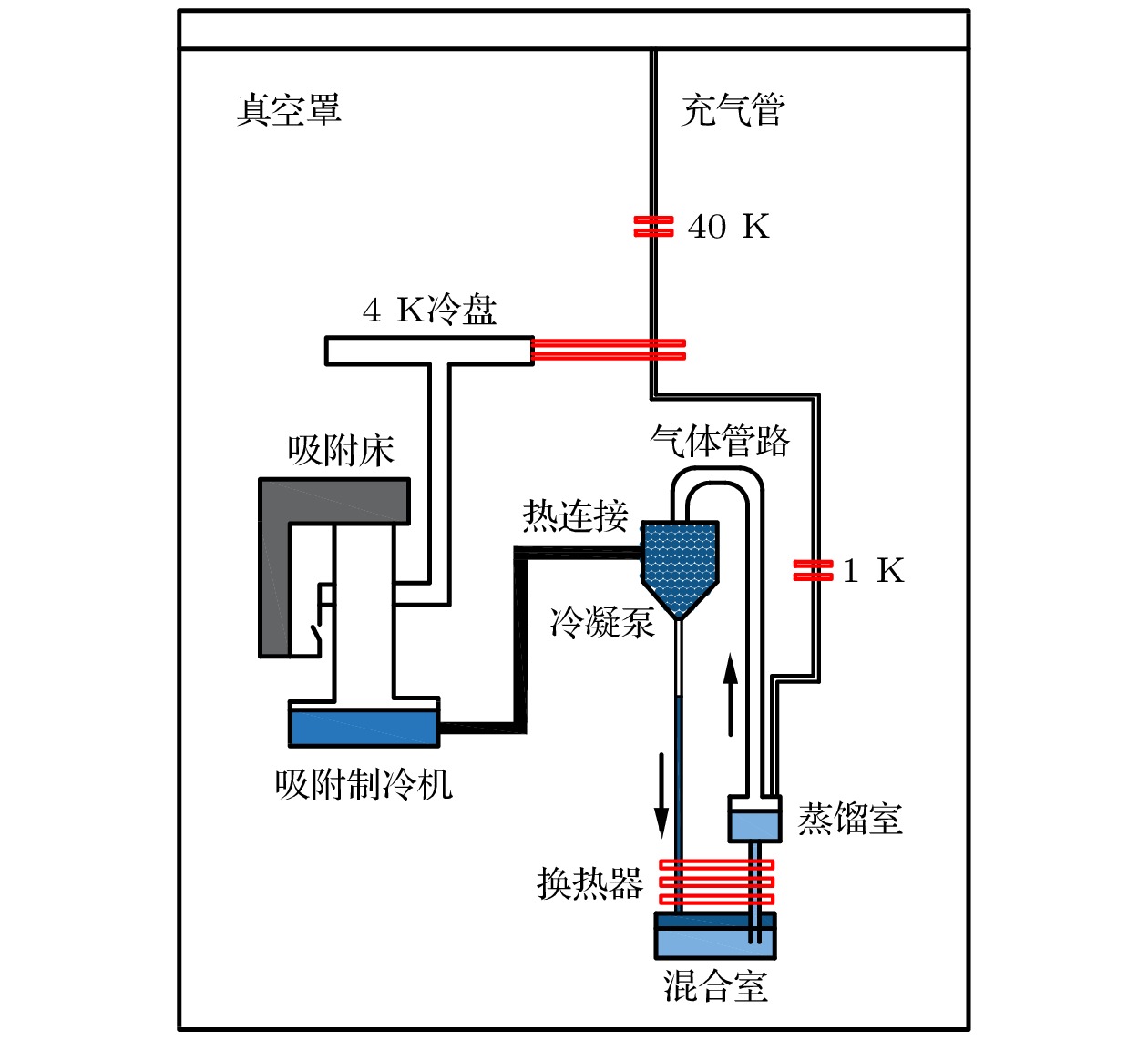
 下载:
下载:
